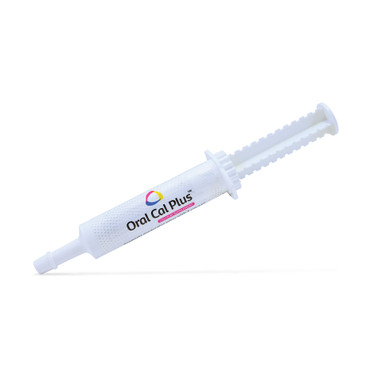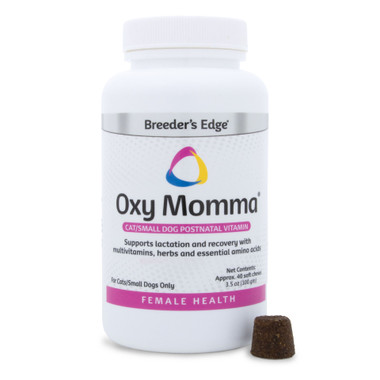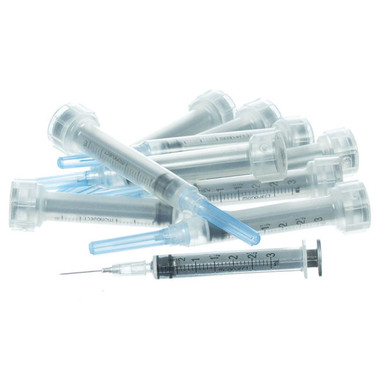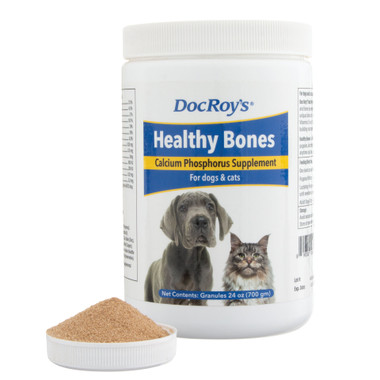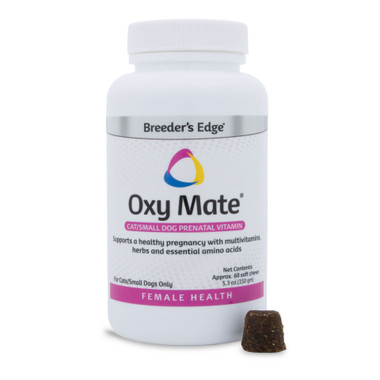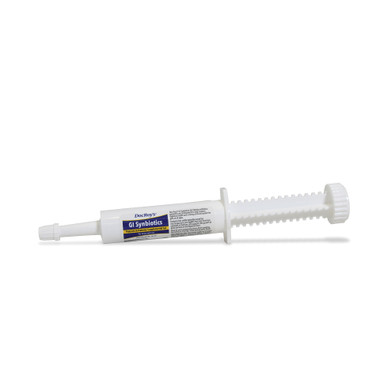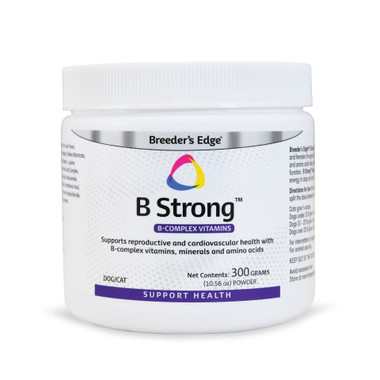Decoding Feline Pica: Understanding, Diagnosing, and Preventing Unusual Eating Habits in Cats
Estimated 0 min read
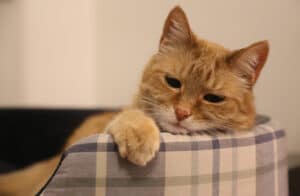
Cat with feline pica
Every cat owner cherishes those quirky feline behaviors, from playful pounces to gentle purring. But what happens when these behaviors hint at something more concerning?
Pica, a condition where cats consume non-food items, often remains shrouded in mystery. While it might seem like a mere oddity, understanding pica’s nuances can be pivotal for your cat’s well-being.
Let’s shed light on this enigmatic behavior, ensuring you’re equipped to recognize and address it effectively.
Facts about pica in cats
- Pica in cats involves consistently consuming non-food items, often due to nutritional deficiencies, psychological factors, or underlying medical conditions.
- Early detection, through keen observation and veterinary assessments, is crucial for effective management and treatment.
- Prevention strategies, including stress minimization and mental stimulation, can significantly reduce the risk of pica development.
Understanding Feline Pica
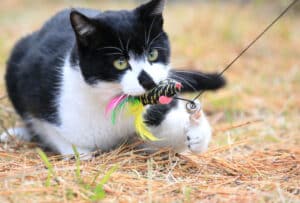
Cat nibbling on a toy
Every cat owner has witnessed their feline friend’s quirky behaviors. But when does a harmless nibble on a toy cross the line into something more concerning? Enter pica in cats.
Pica is a medical term describing the persistent chewing and ingestion of non-food objects. It’s not just a random act of curiosity. Cats with pica might munch on a variety of items, from fabrics and paper to plants and string. While it’s common for kittens to playfully pounce on toys and occasionally pick them up with their mouths, pica is different. It’s when they consistently consume these non-food items.
Now, you might wonder, is a little nibble here and there a big deal? While a one-time incident might not raise eyebrows, regular ingestion can lead to serious health complications. Imagine the harm caused by ingesting chunks of fabric or rubber. Not a pleasant thought.
Interestingly, some cats might display a specific form of pica known as wool-sucking. In this behavior, they’re drawn to suck on blankets, clothing, or other fabrics. It’s a distinct pattern and can be just as concerning as other forms of pica.
The challenge with pica is its ambiguity. Many cats might show mild signs as part of their normal behavior. This makes it tricky to determine when it’s just playful antics or a genuine cause for concern. However, if you notice your cat frequently eating non-food items or if their toys seem to be missing bits and pieces, it’s time to delve deeper.
But what causes this peculiar behavior? And more importantly, how can it be addressed? As we venture further, we’ll uncover the underlying causes and symptoms, helping you ensure your feline friend’s well-being.
Symptoms of Feline Pica
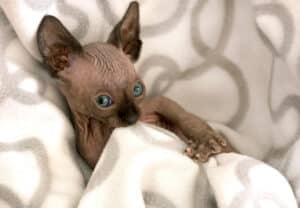
Cat chewing on blanket
When it comes to our feline companions, understanding their behaviors can sometimes feel like decoding a mystery. Pica, with its peculiar tendencies, is no exception. Recognizing the symptoms early can be the key to ensuring your cat’s health and well-being.
First and foremost, the most evident sign of pica is the act itself: the ingestion of non-food items. If you find your cat munching on fabrics, paper, or even plants, it’s a clear indicator. But it’s not just about what they eat; it’s the frequency. An occasional nibble might be harmless curiosity, but regular consumption is a red flag.
Beyond the obvious act of eating non-food items, there are subtler signs to watch for. Has your cat developed a sudden interest in houseplants, perhaps chewing or even uprooting them? This newfound botanical fascination might be more than just play.
Another symptom closely related to pica is wool-sucking. If your cat is frequently found suckling on blankets, clothing, or other fabrics, it’s a behavior that shouldn’t be overlooked. While it might seem endearing or harmless, it’s a manifestation of the same underlying issue.
But pica doesn’t stop at ingestion. The aftermath can be equally telling. If your cat vomits and you spot non-food items within, it’s a direct consequence of their pica behavior. Similarly, if toys or other household items appear chewed up or if there are visible holes in fabrics, it’s time to pay attention.
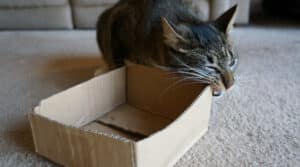
Cat eating cardboard
Other symptoms might be less direct but equally concerning. A decrease in appetite can signal that your cat is filling up on non-food items. Lethargy, too, can be a result of the physical strain or blockages caused by ingesting foreign objects.
It’s also worth noting that while some symptoms, like diarrhea or constipation, might hint at pica, they can also be indicative of other medical conditions. This overlap makes it crucial to consider the entire picture, combining observed behaviors with physical symptoms.
In understanding these signs, you’re equipped to spot the early indicators of pica in your feline friend. But recognizing the symptoms is just the beginning. As we delve deeper, we’ll explore the potential causes behind this behavior, shedding light on the mysteries of feline pica.
Causes of Pica in Cats
While the symptoms of pica in cats can be alarming, understanding the root causes can provide clarity. Pica isn’t just a random behavior; it’s often a manifestation of underlying issues, both medical and psychological.
Nutritional Deficiency
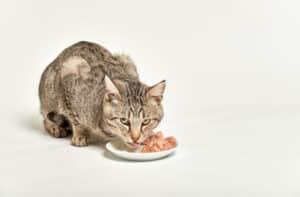
A Pica Cat’s nutritional needs aren’t being met
Cats, like all creatures, have specific dietary needs. When these needs aren’t met, they might resort to unconventional sources for sustenance. Pica, in some cases, is a cat’s desperate attempt to fill a nutritional void. They might ingest non-food items, mistakenly believing they’re getting essential nutrients. Common deficiencies include minerals, vitamins, or proteins. For instance, a cat lacking fiber might consume plant matter, while one deficient in fat could chew on plastic. It’s not just about filling their bellies; it’s a quest for a balanced diet. Recognizing this cause prompts a review of their current diet, ensuring it’s both balanced and fulfilling.
Psychological Factors
The feline mind is a complex realm, influenced by emotions, environment, and experiences. Pica, in some instances, is a manifestation of these psychological intricacies. Boredom, a common culprit, can arise from a lack of mental stimulation, pushing cats to chew on objects as a form of self-entertainment. Anxiety, another significant factor, can stem from changes in the household, disputes with other pets, or even past traumas. In such cases, the act of chewing provides a temporary relief, a coping mechanism of sorts. Social conflicts, especially in multi-pet households, can also lead to stress-induced pica. Understanding these psychological triggers is pivotal, offering insights into a cat’s environment and emotional well-being, guiding interventions that cater to their mental health.
Underlying Medical Conditions
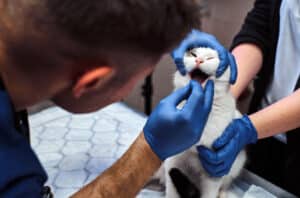
It could be a underlying medical condition
At times, pica isn’t just a behavioral quirk but a symptom of deeper medical concerns. Gastrointestinal diseases, for instance, can disrupt a cat’s digestion and appetite, leading them to seek solace in non-food items. Neurological disorders might alter their perception, making them more inclined to chew or ingest unusual objects. Exposure to certain toxins can also trigger pica, as the body grapples with unfamiliar substances. It’s essential to recognize that while pica is a concern in itself, it might also be a beacon, highlighting other health issues that require attention. Regular vet check-ups, coupled with keen observation, can help pinpoint these medical triggers, ensuring timely intervention and care.
Breed Predisposition
Certain cat breeds seem to have a natural inclination towards pica, suggesting that genetics play a role in this behavior. Notably, Oriental breeds like Siamese and Burmese cats often exhibit wool-sucking or wool-chewing tendencies. While the exact reasons for this breed-specific behavior remain elusive, it’s clear that their genetic makeup predisposes them to such actions. For cat owners of these breeds, awareness is crucial. Recognizing this predisposition allows for proactive monitoring and early intervention. It’s not about labeling a breed but understanding their unique tendencies, ensuring they receive the care and attention tailored to their genetic inclinations.
Early Weaning
The initial weeks of a kitten’s life are foundational, shaping many of their behaviors and tendencies. Early weaning, or the premature transition from mother’s milk to solid food, can have lasting effects. Kittens weaned too soon might develop pica as a lingering response to this abrupt dietary shift. The act of suckling or chewing on objects can be a comfort-seeking behavior, reminiscent of their time nursing. For those raising kittens, it’s vital to ensure a gradual and well-timed weaning process. Consulting with a vet can provide guidance on the optimal timeline, ensuring kittens transition smoothly, reducing the risk of behaviors like pica later in life.
Teething
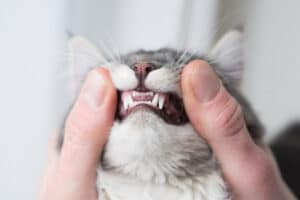
Teething cat
Just as human infants experience the discomfort of teething, kittens go through a similar phase. Typically occurring between 10 weeks and 6 months, teething can lead to an increased desire to chew on objects. This natural urge helps alleviate the discomfort of emerging teeth. It’s not uncommon to find kittens gnawing on soft toys, blankets, or even their owner’s fingers during this period. However, if this chewing behavior persists beyond the typical teething age, it might be indicative of pica. Recognizing the difference between normal teething behavior and prolonged chewing tendencies is essential. While teething is a temporary phase, persistent chewing requires attention and intervention.
Compulsive Disorder
In some feline cases, pica transcends mere habit and ventures into the realm of compulsion. This behavior, driven by an irresistible urge, sees cats repeatedly consuming non-food items despite potential harm. It’s not just a fleeting desire but a deep-seated need. Such compulsive behavior can be likened to human obsessive-compulsive disorders, where actions are repeated, often to the detriment of the individual. Understanding that pica can be a result of such a compulsive disorder is crucial. It shifts the perspective from mere behavioral correction to addressing a deeper psychological issue. With this insight, interventions can be tailored, combining behavioral therapies with potential medical treatments, ensuring a holistic approach to the cat’s well-being.
Understanding these causes is the first step towards addressing the issue. With this knowledge, cat owners can take proactive measures, ensuring their feline friends lead healthy, happy lives. As we move forward, we’ll delve into the diagnostic measures and treatments that can help manage and mitigate pica in cats.
Diagnosing Pica in Cats
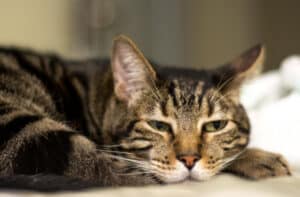
Observe you cats behavior at home
Identifying pica in cats is a blend of keen observation and professional expertise. While the symptoms might hint at this behavior, a definitive diagnosis requires a more structured approach.
Observations at home lay the foundation. Cat owners, being the primary caregivers, play a pivotal role in the diagnostic process. Noting the frequency of the behavior, the items consumed, and any accompanying symptoms can provide invaluable insights. For instance, if a cat is frequently found chewing on fabrics or if toys appear with missing bits, it’s a clear sign that warrants further investigation.
However, home observations, while crucial, are just one piece of the puzzle. A visit to the veterinarian is essential for a comprehensive diagnosis. During this visit, the vet will conduct a detailed history check, delving into the cat’s dietary habits, environment, and any potential stressors. This background information, combined with the owner’s observations, paints a clearer picture of the situation.
Physical exams are the next step. The vet will check for any signs of gastrointestinal blockages, dental issues, or other related health concerns. Bloodwork might also be recommended to rule out nutritional deficiencies or underlying medical conditions that could be triggering the pica behavior.
Diet evaluations are another crucial aspect of the diagnostic process. If a nutritional deficiency is suspected, the current diet will be assessed to identify any gaps. This evaluation can lead to dietary recommendations, ensuring the cat receives all the essential nutrients.
In some cases, further tests might be required, especially if the initial assessments don’t provide a clear answer. These could include imaging tests to check for ingested objects or specialized behavioral assessments to determine if the pica is a result of psychological factors.
The journey to diagnosing pica is a collaborative effort, combining the observations of the cat owner with the expertise of the veterinarian. With a clear diagnosis in hand, the path to treatment and management becomes evident, ensuring the cat’s health and well-being are prioritized.
Preventing Pica in Cats
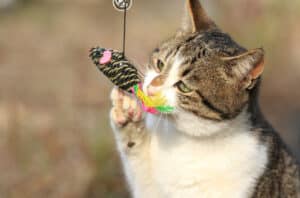
Cat playing with toy
While understanding and diagnosing pica is essential, prevention remains the best approach. By implementing specific strategies, cat owners can reduce the likelihood of pica developing or recurring in their feline companions.
Minimize Stress: A calm environment is pivotal. Cats, sensitive to changes, can manifest stress through behaviors like pica. Ensure a stable routine, introduce new pets or changes gradually, and provide safe spaces for your cat to retreat if they feel overwhelmed.
Mental Stimulation: Boredom can be a significant trigger for pica. Engage your cat with interactive toys, puzzle feeders, and regular play sessions. These activities not only keep them entertained but also cater to their natural hunting instincts.
Natural Hunting and Play: Cats are natural hunters. Providing outlets for these instincts can deter them from unwanted behaviors. Consider toys that mimic prey, like feather wands or motorized toys, to engage their predatory side.
Foraging Feeders: Turn mealtime into a game. Foraging feeders or puzzle feeders require cats to work a bit for their food, mimicking the act of hunting. This not only provides mental stimulation but also slows down their eating, promoting better digestion.
Litter Boxes and Food/Water Stations: Ensure there are enough litter boxes and food/water stations, especially in multi-cat households. This reduces competition and stress, factors that can contribute to pica.
Monitor and Limit Access: If you’ve identified specific items your cat is drawn to, like fabrics or plants, limit their access. Create a cat-friendly space devoid of these temptations, ensuring they can’t indulge in their pica tendencies.
Regular Vet Check-ups: Routine veterinary visits can help identify potential nutritional deficiencies or medical conditions that might lead to pica. Early detection and intervention can prevent the behavior from escalating.
Implementing these preventive strategies requires commitment and consistency. However, the rewards, in the form of a happy, healthy cat, are well worth the effort. As we continue our exploration, we’ll delve into the frequently asked questions surrounding pica, providing clarity and insights for curious cat owners.
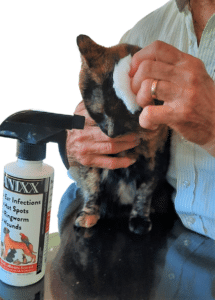
Banixx Pet Care Spray for Cats
Banixx for Cat Lovers
Got questions about your cat? Check out ourcat blog! We’re here to help! Want info on why cats gethairballs? Or why they justcan’t resist CatNip? And if you have other pets (dogs, horses, chickens, etc.), our blog covers them, too! Check it out today – and come back frequently to see what else we’ve posted!
Sources
https://www.petmd.com/cat/conditions/behavioral/pica-cats
https://bettervet.com/resources/pet-health-care/pica-in-cats
https://www.catster.com/lifestyle/pica-in-cats/
cats.com/pica-in-cats






